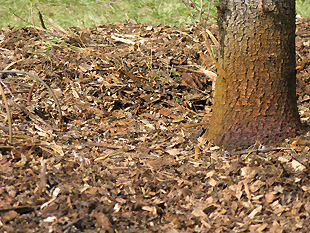Home > Planting trees > Plant details > Mulch is ideal
Mulch is ideal for establishing trees, but do it right
Weed and turf suppression in the root zone during establishment is essential. This can be accomplished by 1) mulching or 2) maintaining the soil around the root ball weed free with herbicides. We found, as others have, that both resulted in the same tree growth and health! In other words the effect of mulch was the same as the effect of eliminating turf and weeds; mulch provided no more benefit than bare ground. Organic mulches have the advantage of adding much needed organic matter to the soil.
- Best mulch management
- Recommended mulch management
- Minimum mulch area
- Not recommended See: Mulch precautions

Pull mulch back away from the trunk and root ball. The point where the top-most root meets the trunk should be within the top 2 inches of the surface. It can be visible at the surface. Notice mulch is spread in a thinner layer on root ball than around root ball. Periodic root collar excavations should check for and remove large roots that grow up and into mulch over the root ball.
Where to place it: Apply a 3-inch thick (after settling) layer of mulch to at least an eight-foot diameter circle around the plant, or maintain the area weed free with herbicides, to help discourage weeds and turf. This area should be maintained during the establishment period at least two feet in diameter (preferably three feet) for each inch of tree trunk diameter (to encourage rapid establishment, minimum diameter should be eight feet for trees with a trunk diameter less than 3 inches). Apply a thinner layer of mulch over the root ball, for aesthetic reasons if you wish, but keep it at least 12 inches from the trunk (24-inch diameter mulch-free area) so the trunk bark can dry. This also allows rainwater, irrigation, and air to easily enter the root ball since it does not have to drain through the mulch. Mulch resting on the trunk and applying too thick a layer can kill the plant by holding water meant for the roots, oxygen starvation, death of bark, stem and root diseases, prevention of hardening off for winter, vole and other rodent damage to trunk, keeping the root ball too wet, encouraging formation of stem girdling roots, and repelling water if the mulch dries out.
Mulch is often applied on the root ball with the intention of conserving moisture in the root ball. There is actually no data that supports this concept. Our recent data (2008) shows that mulch on the root ball has little impact on water loss from the tree since a much larger portion of water lost from the root ball is transpired (about 99%), not evaporated (less than 1%) from the root ball surface (Gilman et al., paper in preparation). Only a small fraction of water leaves the root ball by evaporation (1%) from the surface of the root ball during the growing season. Therefore, downsides of applying mulch on the root ball appear to outweigh potential moisture conserving properties.
Potential benefits: Applying mulch allows roots on newly planted trees to become established quickly according to Watson and Green (1989). However, later work showed that it was lack of turf, not presence of mulch that provided benefits to the newly planted tree (Gilman and Grabosky, 2004). Once the tree is well established in the landscape, it is best for the tree to maintain mulch under the dripline of the tree - no turf under the tree. Some managers reduce the size of the mulched area, but soil can become compacted under the canopy from mowing equipment causing serious damage to the tree in some circumstances. Arborists, botanical gardens, and landscape managers are beginning to realize that trees are much easier to maintain in good health when the soil beneath the canopy is mulched. This probably results from a healthy microbial, earthworm, and insect population and good air penetration into the soil. Within about a year after applying mulch under the canopy, you can feel the soil becoming softer. Roots grow rapidly in soft soil, slowly in compacted soil.
Type: Composted yard waste makes great mulch and may suppress Phytophthora and Armillaria infection in some circumstances. There are a growing number of examples around the US of applying fresh wood chips or bark under the canopy of landscape trees. Landscape managers report that these trees remain healthy and in some circumstances health is improved. Applications of fertilizer have been reduced or in certain cases eliminated in some of these landscapes. Fresh (not composted) wood chips could, in some circumstances, enhance pathogens such as Fusarium and shot gun fungi. If you suspect that this could be a problem in your region, apply it to areas that already have some mulch on the soil. Since non-organic mulches, such as rubber or lava rock, add nothing to the soil they may be less desirable than organic mulches. However, synthetic mulches may have applications where organic mulches might blow or wash away.
Mulch from coniferous plants is best for conifers; hardwood mulch is probably best for hardwood plantings. Conifer mulches could reduce the soil pH in some cases to levels undesirable for hardwoods. Hardwood mulches could increase the soil pH to levels undesirable for conifers. Organic mulches of many types can support growth of artillery fungus (Sphearobolus stellatus) which can discolor nearby buildings, cars and walks.
Mulches with particle size distribution resulting in tight packing of mulch particles should be avoided. The include mulches with a large difference in particle sizes. Some of these can repel rain and irrigation water beginning several months after planting.

